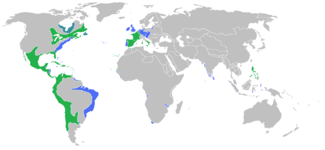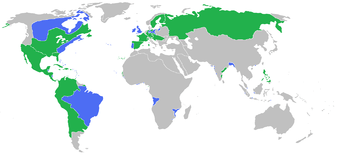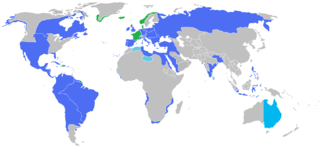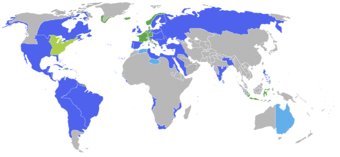World war

the Allies in green, the Central Powers in orange, and neutral countries in grey
A world war is a war involving some of the world's most powerful and populous countries. World wars span multiple countries on multiple continents, with battles fought in multiple theaters.
The term is usually applied to the two conflicts that occurred during the 20th century:
- World War I (1914–1918)
- World War II (1939–1945)
However, it is also sometimes applied to earlier wars, the Cold War, the Cold War II, or to a hypothetical World War III.
Origins of the term

Bourbon France and Spain and their allies in green, the Habsburg empire and Spain and their allies in blue, and neutral countries in grey.

Prussia, Spain, France and their allies in green, Austria and its allies in blue, and neutral countries in grey.

France, Austria, Spain and their allies in green, Great Britain, Prussia, and their allies in blue, and neutral countries in grey.

France and Denmark in green, the Holy Roman Empire, Spain, Great Britain, and their allies in blue,[3] and neutral countries in grey.

France and its clients and allies in green,[4] the United Kingdom, Spain and its coalition in blue,[3] and neutral countries in grey.
The term "World War" was coined speculatively in the early 20th century, some years before the First World War broke out, probably as a literal translation of the German word Weltkrieg.[5] German writer August Wilhelm Otto Niemann had used the word in the title of his anti-British novel Der Weltkrieg: Deutsche Träume ("The World War: German Dreams") as early as 1904, published in English as The coming conquest of England. Also, the term was used as early as 1850 by Karl Marx in The Class Struggles in France, as well as his associate Friedrich Engels.[6] The Oxford English Dictionary cites the first known usage in the English language as being in April 1909, in the pages of the Westminster Gazette.
It was recognized that the complex system of opposing alliances–the German Empire, Austria-Hungary, and the Ottoman Empire vs. the French Third Republic, the Russian Empire, and the British Empire was likely to lead to a worldwide conflict in the event of war breaking out. Due to this fact, a very minute conflict between two countries has the potential to set off a domino effect of alliances, causing mass war. The fact that the powers involved had large overseas empires virtually guaranteed that a war would be worldwide, as the colonies' resources would be a crucial strategic factor. The same strategic considerations also ensured that the combatants would strike at each other's colonies, thus spreading the fighting far more widely than in the pre-colonial era.
Other languages have also adopted the "World War" terminology. For instance, in French, "World War" is translated as "Guerre Mondiale"; in German, "Weltkrieg", which, prior to the war, had been used in the more abstract meaning of a global conflict; in Italian, "World War" is translated as "Guerra Mondiale"; in Spanish, — Guerra Mundial, and in Russian, — Mировая Bойна (Mirovaya Voyna).
Speculative fiction authors were noting the concept of a Second World War at least as early as 1919 and 1920,[7] when Milo Hastings wrote his dystopian novel City of Endless Night. In English, the term "First World War" was used by Charles à Court Repington as a title for his memoirs, published in 1920,[8] having originally discussed the matter with a Major Johnstone of Harvard University in September 1918.[9] The term "World War I" was invented by Time magazine in its issue of June 12, 1939.[10] In that same article, the term "World War II" was first used speculatively to describe the upcoming war.[11] The first use for the actual war came in its issue of September 11, 1939.[12] One week earlier, the Danish newspaper Kristeligt Dagblad used the term on its front page, saying "The second World War broke out yesterday at 11 a.m."[13]
Large-scale wars before 1914
Before the 20th century, there were a number of wars with battles spanning two or more continents, including:
- the Greco-Persian Wars (499–449 BC)
- the Wars of Alexander the Great (335–323 BC)
- the Wars of the Diadochi (322–275 BC)
- the First Punic War (264–241 BC)
- the Second Punic War (218–201 BC)
- the Roman–Syrian War (192–188 BC)
- the Roman–Persian Wars (92 BC –AD 629)
- the First Mithridatic War (89–85 BC)
- the Great Roman Civil War (49-45 BC)
- the Byzantine–Sassanid wars (AD 502–628)
- the Muslim conquests (622–1258)
- the Arab–Byzantine wars (629–1050s)
- the First Crusade (1096–1099)
- the Second Crusade (1145–1149)
- the Mongol conquests (1206–1324)
- the Byzantine–Ottoman Wars (1265–1479)
- the Ottoman–Habsburg wars (1526–1791)
- the Eighty Years' War (1568–1648)
- the Anglo-Spanish War I (1585–1604)
- the Dutch–Portuguese War (1602–1663)
- the Thirty Years' War (1618–1648)
- the Anglo-Spanish War II (1625–1630)
- the Anglo-Spanish War III (1654–1660)
- the Nine Years' War (1688–1697)
- the War of the Spanish Succession (1701–1714)
- the War of the Quadruple Alliance (1718–1720)
- the Anglo-Spanish War IV (1727–1729)
- the War of the Austrian Succession (1740–1748)
- the Seven Years' War (1754–1763)
- the Anglo-Spanish War V (1761–1763)
- the American Revolutionary War (1775–1783)
- the French Revolutionary Wars (1792–1802)
- the Anglo-Spanish War VI (1796–1808)
- the Napoleonic Wars (1803–1815)
- the Crimean War (1853–1856)
Before the late 19th century, the concept of a world war would be the result of military action caused by quarrels between European powers which took place in fairly limited, though sometimes far-flung, theaters of conflict.
Wars matching World War I by casualty count
There were a number of wars before the 20th century with as many or more casualties than the First World War (16,563,868 – 40,000,000), including:
- 30,000,000 – 60,000,000 Mongol conquests (1206–1324) [14][15][16][17] --- may be underestimated
- 25,000,000 Manchu conquest of China (1616–1662) [18]
- 20,000,000 Taiping Rebellion (1850–1864) [19] --- may be underestimated
Large-scale wars after 1945
Most wars listed are considered part of conflicts such as the Indochina Wars, the Conflict in Afghanistan, the Gulf Wars, the War on terror, and the Cold War.
World War I and World War II
The World Wars of the 20th century involved almost every continent on Earth. Many of the states who fought in the First World War also fought in the Second, although not always on the same sides.
The two World Wars of the 20th century caused unprecedented casualties and destruction across the theaters of conflict, although there are at least three wars before the 20th century with as many or more casualties than the First World War.[20] The numbers killed in both wars combined are estimated at between 60 and 100 million people. Non-combatants (mostly civilians) suffered as badly as or worse than combatants, and the distinction between combatants and non-combatants was often blurred as belligerents of both world wars mobilized for total war. Both world wars saw war crimes. Nazi Germany was responsible for multiple genocides during the Second World War, most notably the Holocaust. The Soviet Union, Canada, and United States deported and interned minority groups within their own borders, and largely due to this conflict later, many ethnic Germans were expelled in much of Eastern Europe. Imperial Japan during the Second World War was notorious for attacking neutral nations without a declaration of war, such as the bombing of Pearl Harbor, and its brutal treatment and killing of Allied prisoners of war and the inhabitants of Asia, most notably by using them for forced labor and the Rape of Nanking where 250,000 non-combatants in the city were brutally murdered by Japanese troops. The Ottoman Empire was responsible for the death of over one million Armenians during the First World War. Advances in technology were responsible for a large amount of casualties. The First World War saw major use of chemical weapons despite the Hague Conventions of 1899 and 1907 outlawing the use of such weapons in warfare. The Second World War was also the first (and thus far, only) conflict in which nuclear weapons were used, devastating the Japanese cities of Hiroshima and Nagasaki.
| World War I | World War II | |
|---|---|---|
| Dead | 15–20M | 50–85M |
| Injured | 9–15M | 20M |
| Conscripts | 65M | 90M |
| Battlefield size | 3M km² | 17M km² |
The outcome of the World Wars had a profound effect on the course of world history. The old European empires collapsed or were dismantled as a direct result of the wars' crushing costs and in some cases the defeat of imperial powers. The United States was firmly established as the dominant global power, along with its ideological foe, the Soviet Union, in close competition. These two superpowers exerted political influence over most of the world's other states for decades after the end of the Second World War (ending in the late 1980s in the Soviet Union). The modern international security, economic and diplomatic system was created in the aftermath of the wars. Institutions such as the United Nations were established to collectivize international affairs, with the explicit goal of preventing another outbreak of general war. The wars also greatly changed the course of daily life. Technologies developed during wartime had a profound effect on peacetime life as well–for instance, jet aircraft, penicillin, nuclear energy, and electronic computers.
Since the atomic bombings of Hiroshima and Nagasaki during the Second World War, there has been a widespread and prolonged fear of a Third World War between nuclear-armed powers.
Later world wars
I know not with what weapons World War III will be fought, but World War IV will be fought with sticks and stones.
Various former government officials, politicians and authors have attempted to apply the labels of WWIII, WWIV, and WWV to various military engagements and diplomatic stand-offs since the close of WWII, such as the Cold War or the War on Terror. Among these are former American and French government officials James Woolsey[23] and Alexandre de Marenches,[24] author Eliot Cohen[25] and Zapatista leader Subcomandante Marcos.[26] Despite their efforts, none of these wars are commonly deemed world wars.
The Second Congo War (1998–2003), which involved nine nations and led to ongoing low-level warfare despite an official peace and the first democratic elections in 2006, has often been referred to as "Africa's World War".[27]
World War III is generally considered a hypothetical successor to World War II and is often suggested to be nuclear, devastating in nature and likely much more violent than both WWI and WWII combined. This war is anticipated and planned for by military and civil authorities, and explored in fiction in many countries. Concepts range from purely conventional scenarios or a limited use of nuclear weapons to the destruction of the planet. World War IV is sometimes mentioned as a hypothetical successor to World War III or as a plot element in books, movies or video games.
See also
- The Great Game (1813–1907)
- List of wars by death toll
- List of wars and anthropogenic disasters by death toll
- List of genocides by death toll
- List of largest empires
- List of pre-modern great powers
- First wave of European colonization
- New Imperialism
- Revolutionary wave
- Neocolonialism
- Cold War
- Cold War II
- War on Terror
- War on Drugs
- List of largest cities throughout history
- Historical urban community sizes
References
- ↑ Those in light green joined the Allies between 7 December 1941 and 14 August 1945. The Xikang region of neutral Tibet was also under Allied Chinese control.
- ↑ Churchill, Winston. A History of the English-Speaking Peoples, op. cit. in Laura Scanlan's "Clash of Empires." Humanities. HighBeam Research, 2005. Accessed 12 May 2012.
- ↑ 3.0 3.1 The territories only nominally controlled by the British and Ottomans—such as New South Wales and the Barbary States—in light blue.
- ↑ The United States was only at war with the United Kingdom.
- ↑ "Online Etymology Dictionary entry for World War". Etymonline.com. 1914-08-02. Retrieved 2012-08-24.
- ↑ Engels, Frederick. "Introduction to Borkheim".
- ↑ Hastings, Milo (1920). City of Endless Night. Dodd, Mead. Retrieved 20 October 2014.
- ↑ Repington, Charles à Court (1920). The First World War, 1914-1918. Retrieved 20 October 2014.
- ↑ "The 'First' World War". QI : Quite Interesting. 2014. Retrieved 20 October 2014.
- ↑ "War Machines". TIME. June 12, 1939. Retrieved 20 October 2014. (subscription required (help)).
In World War I, for example, command of the air changed hands several times, and the command changed not only when numbers varied but when one side introduced a superior new plane which could outfight the opposing machines
- ↑ "In World War II it is possible that even nations who do not take sides may play a vital military part, for they may be invaded."
- ↑ "Grey Friday: TIME Reports on World War II Beginning". TIME. September 11, 1939. Retrieved 20 October 2014.
World War II began last week at 5:20 a. m. (Polish time) Friday, September 1, when a German bombing plane dropped a projectile on Puck, fishing village and air base in the armpit of the Hel Peninsula.
- ↑ "Den anden Verdenskrig udbrød i Gaar Middags Kl. 11", Kristeligt Dagblad, September 4, 1939.
- ↑ White, Matthew (2012). Atrocities: The 100 Deadliest Episodes in Human History. New York, NY: W. W. Norton. p. 271, 578. ISBN 9780393345230. Retrieved 17 May 2014.
- ↑ McEvedy, Colin; Jones, Richard M. (1978). Atlas of World Population History. New York, NY: Puffin. p. 172. ISBN 9780140510768.
- ↑ Ping-ti Ho, "An Estimate of the Total Population of Sung-Chin China", in Études Song, Series 1, No 1, (1970) pp. 33–53.
- ↑ "Mongol Conquests". Users.erols.com. Retrieved 2011-01-24.
- ↑ McFarlane, Alan: The Savage Wars of Peace: England, Japan and the Malthusian Trap, Blackwell 2003, ISBN 0-631-18117-2, ISBN 978-0-631-18117-0 – cited by White
- ↑ "Taiping Rebellion – Britannica Concise". Concise.britannica.com. Retrieved 2011-01-24.
- ↑ "Top 10 Causes of WWI". The Rich Ten. Retrieved 11 June 2014.
- ↑ Calaprice, Alice (2005). "The new quotable Einstein". Princeton University Press. p. 173. ISBN 0-691-12075-7.
- ↑ "The culture of Einstein". MSNBC. 2005-04-19. Retrieved 2012-08-24.
- ↑ "World War IV". 2002. Retrieved 2010-02-04. Woolsey claims victory in WWIII, start of WWIV
- ↑ "The Fourth World War: Diplomacy and Espionage....". 1992. Retrieved 2010-02-04. Book regarding alleged WWIV
- ↑ "World War IV: Let's call this conflict what it is.". 2001. Retrieved 2010-02-04. Why war on terrorism should be called WWIV
- ↑ Subcomandante Marcos (2001). "The Fourth World War Has Begun". Nepantla: Views from South (Duke University Press) 2 (3): 559–572. Retrieved 20 October 2014.
- ↑ Prunier, Gerard (2014). Africa's World War: Congo, the Rwandan Genocide, and the Making of a Continental Catastrophe. Barnes & Noble. ISBN 9780195374209. Retrieved 20 October 2014.
External links
- This is the Fourth World War, an interview with philosopher Jean Baudrillard
